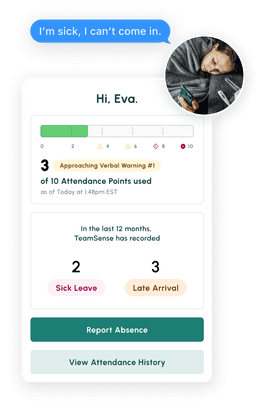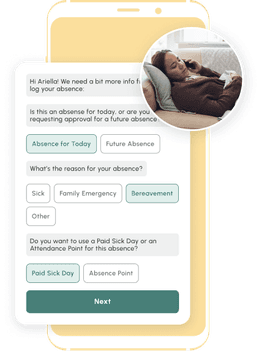When to HR with AI (and When Not To)!
Table of Contents
- What is an Employee Attendance Improvement Plan?
- Why Do You Need an Employee Attendance Improvement Plan?
- Understanding the impact of poor attendance
- 4 Things to Make Sure You Include In The Improvement Plan Document
- How to Create an Employee Attendance Improvement Plan
- How Technology Can Support Attendance Improvement
- Best Practices for Successful Implementation
- Common Mistakes to Avoid
So, it's become clear: an employee attendance improvement plan isn't just a good idea; it's a necessity for your team. But where do you start with creating one? Navigating the nuances of crafting an attendance improvement plan - striking the right balance between critical details and genuine dialogue - can seem daunting. This guide will be your companion, walking you through every step in designing an effective attendance improvement plan. Let's dive in and explore how we can turn those frequent absences into consistent, improving employee attendance together.
What is an Employee Attendance Improvement Plan?
An employee attendance improvement plan is an official document that usually comes from a supervisor or manager to address an employee’s excessive absenteeism or chronic absenteeism.
Simply put, an Employee Attendance Improvement Plan is your game plan to reduce absenteeism, your strategy for better attendance, that you share with a team member. It's a well-thought-out action plan for nudging those frequent absentees in your team to show up more consistently and help keep your operations running smoothly while avoiding the dreaded no call no show.
In essence, it's a proactive and structured approach to address frequent and unplanned absences. But it's not just about having strict rules and consequences. A great plan also includes open communication, clear attendance expectations and guidelines beforehand, and a better understanding of individual employee needs.
It's about creating a work environment where everyone understands the importance of regular attendance and how their absences can impact the team and company's overall performance. With a well-crafted Employee Attendance Improvement Plan, you're not just boosting employee's attendance record; you're also up employee engagement and fostering a more engaged and responsible team.
Why Do You Need an Employee Attendance Improvement Plan?
Attendance issues can feel like a small annoyance at first—a missed shift here, a late clock-in there—but over time, they add up to much bigger problems. That’s where an employee attendance improvement plan comes in. It’s not just about tracking who’s late or absent; it’s about creating a framework that keeps your team running smoothly and ensures everyone is on the same page.
Here’s why having an attendance improvement plan is a must for your business:
1. Minimize Productivity Loss
When employees don’t show up, the work doesn’t just magically disappear. Deadlines are pushed, projects are delayed, and productivity takes a hit. For industries like manufacturing or healthcare, even one absence can throw off the entire workflow. A structured plan helps you address attendance issues proactively, so you can minimize these disruptions and keep things moving.
2. Boost Team Morale
Let’s face it—when one person doesn’t pull their weight, it often falls on someone else to pick up the slack. Over time, this can lead to resentment, burnout, and a drop in team morale. An attendance improvement plan ensures accountability and fairness, so everyone feels like they’re contributing equally to the team’s success.
3. Prevent Financial Loss
Poor attendance doesn’t just cost time—it costs money. Missed shifts, overtime pay to cover gaps, and delayed projects all chip away at your bottom line. Studies show that absenteeism costs U.S. businesses hundreds of billions annually in lost productivity. An attendance improvement plan helps you nip these costs in the bud by encouraging consistent attendance.
4. Encourage Accountability
One of the biggest benefits of an attendance improvement plan is that it sets clear expectations. Employees understand what’s expected of them, and they’re held accountable for meeting those standards. This doesn’t just improve attendance—it fosters a sense of responsibility and commitment among your team.
5. Support Employee Growth
An attendance improvement plan isn’t just about penalties—it’s about support. By addressing attendance issues directly, you can identify the root causes, whether it’s personal challenges, workplace stress, or confusion about policies. This opens the door to honest conversations and gives you a chance to provide the tools or resources employees need to succeed.
6. Promote a Culture of Fairness
Nothing frustrates a team more than feeling like some people get away with bad behavior. A consistent, transparent attendance plan creates a level playing field for everyone, reinforcing a culture of fairness and mutual respect.
Understanding the impact of poor attendance
Poor attendance. Two words that can send shivers down a manager's spine. It's like that mysterious knock in your car's engine — ignore it, and it's likely to lead to bigger issues down the line. So, let's take a closer look at why we should tackle poor- attendance problems head-on.
First up, the not-so-fun fact: habitual or excessive employee absenteeism can put a serious dent in your business operations. Think about it. A team member doesn't show up for work, and their tasks are left hanging. Deadlines are missed, clients are kept waiting, and projects get delayed. It's like a domino effect, and the end result? A noticeable hit on your bottom line. Frequent call-offs or no call, no shows can slow down or stop a production line..
But it's not just about missed work. Poor attendance can also shake up team dynamics. When a team member frequently doesn't show up, others have to step in to pick up the slack. Over time, this can breed resentment, lower employee morale, and cause team productivity to take a nosedive.
And, let's not forget the impact on the absentee themselves. Regularly missing work can lead to them feeling disconnected from the team, out of the loop on projects, and can stifle their career progression.
Understanding the potential fallout of poor attendance is crucial. It's not about playing hardball, but recognizing that regular attendance plays a vital role in the health of your team, boost employee morale, and business. And that, my friends, is where a well-crafted Employee Attendance Improvement Plan steps in to save the day!

Why an Attendance Improvement Plan is Your Business's Best Friend
- Clears the Fog: Sets out clear expectations about attendance, reporting absences, and the consequences of frequent no-shows.
- Opens Dialogue: Encourages open communication between employees and management, providing a space to discuss and address attendance issues.
- Promotes Accountability: By understanding the impact of their attendance on the business, employees become more responsible and mindful of their actions.
- Nurtures a Positive Environment: Recognizing and rewarding good attendance can boost morale and reinforce a positive shift in behavior.
- Fosters Mutual Respect: Balancing the company's needs with employee circumstances encourages a culture of understanding and respect.
In essence, an Attendance Improvement Plan is more than just a set of rules – it's a tool for creating a more engaged and accountable team. Ready to dive in and create your own? Let's go!
4 Things to Make Sure You Include In The Improvement Plan Document
When writing your document or creating your own template, it is important to include basic information below; we've outlined four key components of a standard employee's performance and improvement plan below. You can use the examples below to frame up your own employee attendance improvement plan (or check out this template for inspiration).
- Documented Instances: Keep track of the dates and times your employee didn't adhere to the company attendance policy. Concrete examples always help.
- Impact Analysis: Illustrate how frequent tardiness or absences have affected the team and business operations. The goal isn't to blame, but to show the ripple effect of their actions.
- Clear Expectations: Establish a clear understanding of shift hours. When exactly should they clock in each day?
- Outlined Consequences: Explicitly state the repercussions for frequent absenteeism and tardiness. What could potentially happen if things don't change.
These elements are just a starting point. Depending on your specific needs, you might want to add more details. But remember, the goal of your employee attendance improvement plan is to craft a framework that resonates with your company's unique culture and operational needs.
How to Create an Employee Attendance Improvement Plan
Taking the plunge into creating an Employee Attendance Improvement Plan might seem intimidating. But don't fret - it's a manageable process. Let's break it down into actionable steps to help you build a robust plan. Follow along, and you'll have a game-changing strategy to improve attendance, and job satisfaction in no time!
Go Over Your Attendance Policy
Let’s be clear—every company should have an attendance policy. It’s pretty much an industry standard when it comes to running a business. You need one so that employees (and managers) can be held accountable. If you don’t have an attendance policy in place, your employees won’t know that excessive absenteeism is a problem. That’s why it’s worth taking some time to sit down and think through exactly what is in your attendance policy.
Ideally, you’ve already got an attendance policy in place and just need to talk through it again with your employee. Make sure they’re aware of the policy and answer any questions they might have about it.
Set Expectations
Right from the start, you want to make sure your expectations of the employee are clearly known. The employee has an issue with absenteeism, and you need them to make a change in order to stay employed at your company. And if these changes aren’t seen and expectations aren’t met, clearly express what the consequences would be.
Be Clear
Truth be told, this whole thing might feel like an awkward conversation to have. And that’s normal. But you’re going to have to lean into that uncomfortable feeling and have clear communication here. Getting feedback from managers can make a difference in how engaged an employee is. Gallup found that employees who get meaningful feedback are four times more likely to be engaged.1
Try to be as specific and detailed as you can be. Remember, you want to help your employees make positive changes to improve their attendance records, which requires being a straight talker.
This is where having a solid employee attendance improvement plan template will come in handy. Having something jotted down in black and white (either paper or electronic PDF) will make sure that everything is documented clearly.
Be Consistent
No matter what steps you decide to take in the employee attendance improvement plan—be consistent. Do what you say you’re going to do. If you don’t follow through, it can open up a real can of worms here—especially if you dish out the consequences to one employee but then let another employee slide. Make sure you’re being consistent across your team and treating everyone the same.
Be Sincere
It’s important to keep open lines of communication with your team members—even when you have to correct their actions. Don’t forget to genuinely express your desire that they change their absent habits and perform a complete 180-degree change. You’re rooting for them! Be sure they know that you want things to change and believe they can.
Show the employee that you want to aid them in fixing their absence issues. You can even offer to help them with finding the resources employee assistance programs they may need to make the change (like secure transportation, or health care options).

Is your call-in process terrible? Text reduces no-shows and absenteeism by up to 40%.
Don't believe us? Check out this case study to see how this 3PL benefited.
Remind Them How To Report an Absence
We live in a world where employees get sick, take vacation, and miss work—that’s okay. But remind your employees that they need to communicate with you when they need to take time off or take sick leave or have an unplanned absence. Give them a refresher on the process and who they need to notify.
It’s no secret that absence management can be tricky. If your attendance management process needs an upgrade, learn how our call-off solution through text can make your life a whole lot easier. And remember, it’s in your interest to make it easier to call-off. When you help employees avoid the hold time, inconvenience or discomfort of talking to their manager, they’re more likely to follow the process, which reduces no call, no shows.
Follow Up
Be sure to set time aside to revisit the attendance improvement plan with your employee. Be specific and set markers to take a look at the situation again. For example, maybe you want to regroup and talk again in 30 days, maybe just once a quarter. Whatever time you decide on, make sure you and your employee are on the same page.
Track Progress
Everyone wants to know they’ve made progress. Make sure you’ve set a path to be able to track progress so your employee can see where they’ve knocked it out of the park and where they still need improvement.
When you meet up to address the attendance improvement plan again, make sure you have these tangible markers to discuss the awesome growth or lack of progress you’ve seen. If you're not seeing the expected results, you may consider an automated call out line.
How Technology Can Support Attendance Improvement
Technology is your secret weapon for tackling attendance challenges. It simplifies processes, boosts transparency, and equips both employees and managers with the tools to stay on track.
Digital systems like TeamSense make real-time attendance tracking effortless. Employees can check their attendance records before calling off, helping them make informed decisions and reducing surprises. Reporting absences is also easy—employees can simply text "ABSENT" to notify managers instantly, cutting down on miscommunication and no-shows.
Tech tools do more than track attendance—they automate reminders, flag absences, and provide data insights. Managers can spot patterns, like frequent absences on certain days, and address issues proactively. They also ensure compliance with labor laws by flagging protected absences and maintaining detailed records, reducing legal risks.
Technology also keeps things positive. Gamify your attendance data by recognizing employees for perfect records or major improvements. Small rewards or shout-outs can go a long way in motivating your team.
When managing on-site, tools like TeamSense make attendance management seamless, transparent, and effective. By integrating smart tech into your attendance improvement plan, you can create a system that’s easy to use and delivers real results.

No one wants to talk to their boss or a 1-800 stranger to call off. Text changes everything - Reducing No Call No Shows.
Best Practices for Successful Implementation
An employee attendance improvement plan is only as good as its implementation. To ensure success, focus on clear communication, fairness, and ongoing support.
Start by explaining the plan clearly in one-on-one conversations. Provide written documentation, answer questions, and ensure employees fully understand expectations and consequences. Set realistic goals, such as “Arrive on time for all shifts over the next 30 days,” and include milestones to track progress.
Offer support tailored to individual needs, like flexible schedules or transportation help. Consistency is critical—apply the plan fairly across all employees and document every step to maintain transparency. Regular check-ins at 30, 60, or 90-day intervals can keep employees engaged, allowing you to celebrate wins or address ongoing issues.
Recognize positive changes to boost morale. Simple rewards, like extra PTO or public shout-outs, can motivate employees to stay on track.
Lead with empathy—show genuine concern and acknowledge external factors that may affect employee presence and attendance. Keep the process transparent so employees know what’s expected and how they’re progressing. Finally, review and refine the plan as needed to ensure long-term effectiveness and adaptability.
By following these best practices, you’ll not only address attendance issues but also build trust and foster a culture of accountability.
Common Mistakes to Avoid
Even the best employee attendance improvement plans can falter if you’re not careful to sidestep common pitfalls. Here are some mistakes to watch for—and how to ensure your plan stays on track.
- Being Too Punitive
Focusing solely on penalties can demotivate employees and breed resentment. Instead, balance accountability with empathy, emphasizing support and improvement over punishment. - Ignoring Underlying Issues
Absenteeism often stems from deeper problems like burnout, health concerns, or personal challenges. Take the time to talk to employees, identify root causes, and provide resources such as mental health support, flexible scheduling, or transportation assistance. - Lack of Consistency
Inconsistent enforcement can lead to perceptions of favoritism and damage morale. Apply the plan fairly across all employees, and document every case to maintain transparency and build trust. - Setting Unrealistic Expectations
Rigid or unattainable goals can set employees up for failure. Instead, set specific, measurable, and achievable targets, allowing time for gradual improvement. - Poor Communication
Ambiguity about expectations or consequences can derail even the best plans. Clearly outline the plan in writing and discuss it during one-on-one meetings. Provide regular feedback to keep employees on track. - Failing to Follow Up
Without regular check-ins, employees may feel unsupported or lose motivation. Schedule follow-ups to review progress, address challenges, and celebrate successes. Use these opportunities to adjust the plan if needed. - Overlooking Recognition
Focusing only on negatives, like absences, can overshadow positive changes. Celebrate milestones—such as a month of perfect attendance—with public recognition, gift cards, or extra PTO to motivate improvement. - Neglecting to Use Technology
Manually tracking attendance is tedious and prone to errors. Tools like TeamSense streamline tracking, provide real-time attendance records, and simplify reporting, helping employees stay informed and engaged. - Failing to Address Policy Gaps
An unclear attendance policy can create confusion and undermine your plan. Review and update your policy to include reporting procedures, protected absences, and consequences for non-compliance. - Not Measuring Success
Without tracking results, you won’t know if your plan is working. Set measurable goals, document progress, and evaluate the plan’s effectiveness. Use insights to refine and improve your approach for the future.
By avoiding these common mistakes, you’ll ensure your attendance improvement plan is fair, effective, and aligned with your team’s needs. A well-implemented plan not only addresses absenteeism but fosters a culture of accountability and support.
Building a Stronger, More Reliable Team
Implementing an employee attendance improvement plan is about more than reducing absences—it's about fostering a culture of accountability, support, and mutual respect. By addressing attendance issues proactively, you’re not just solving a problem; you’re investing in your employee relations and team’s success and creating a workplace where everyone can thrive.
Remember, the key to a successful plan is balance. Clear communication, empathy, and consistency are just as important as setting expectations and tracking an employee's progress. Leverage tools like TeamSense to simplify the process, give employees real-time access to their attendance records, and streamline absence reporting. Technology can be your ally in creating a transparent and efficient system.
Finally, don’t forget to celebrate progress along the way. Recognizing positive changes boosts morale and encourages continued improvement. When employees feel supported and valued, they’re more likely to show up—not just physically, but fully engaged and ready to contribute.
With a well-crafted attendance improvement plan, you’re not just managing attendance—you’re building a stronger, more reliable team that’s ready to tackle challenges and achieve great things together.
About the Author

Sheila Stafford, CEO of TeamSense & AI in HR Innovator
As CEO of TeamSense, Sheila Stafford is at the forefront of transforming HR for frontline teams through AI-driven solutions. With a commitment to enhancing employee relations and simplifying workforce management, Sheila leads TeamSense in pioneering advancements that empower both frontline employees and HR teams. Her visionary approach combines cutting-edge technology with a thoughtful focus on enhancing human connection; Sheila strategically implements AI where it adds the most value while recognizing the critical role of personal interaction and ensuring that human engagement remains central when it matters most. Under her leadership, TeamSense is redefining how companies support and engage their frontline teams for a more connected, efficient workplace.





